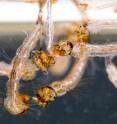Argentinian researchers develop trap for mosquito that transmits Zika
Argentinian researchers from the Centro de Investigaciones de Plagas e Insecticidas have developed a new trap that can be used to effectively monitor and control the Aedes aegypti mosquito, which is the primary transmitter of Zika, dengue, chikungunya, and yellow fever. The trap is described in the Journal of Medical Entomology. The plastic ovitrap is a small cup made of low-density polyethylene (LDPE) that has been infused with the larvicide pyriproxyfen. When the cup is filled with water, the larvicide is immediately released from the plastic.
Female Aedes aegypti mosquitoes prefer to deposit eggs in small containers such as pots and tires that contain water, so the trap is an attractive egg-laying location.
"This is a great idea," said Grayson Brown, an entomologist at the University of Kentucky, who was not involved in the research. "Pyriproxyfen likes to move around in the environment. Molding it into the plastic like that keeps it where you put it."
Although ovitraps have been used for decades as a means of conducting mosquito surveillance, the use of plastic containing the larvicide pyriproxyfen is a new development in the effort to control mosquitoes. In their study, the researchers tested the trap on laboratory-raised Aedes aegypti mosquitoes and reported that the larvicide was 100 percent effective in preventing the larvae from developing into adults.
Pyriproxyfen has gained notoriety through false reports by activists who claimed that it caused microcephaly. However, that claim was debunked by the Entomological Society of America. The Brazilian government has also stated that the association between the use of pyriproxyfen and microcephaly has no scientific basis.
Pyriproxyfen is a juvenile hormone analog that prevents insect larvae from developing into adults. It is one of several pesticides recommended by the World Health Organization Pesticide Evaluation Scheme.
Dr. Brown, who recently co-organized a meeting in Brazil called the Summit on the Aedes aegypti Crisis in the Americas, thinks that the cups would be most effective on a neighborhood basis, with perhaps one or two cups in the equivalent of a back yard. He also believes that the concept of pyriproxyfen embedded in plastic can go well-beyond the small cups used in the study.
"When I read through the paper, I immediately started thinking of disposable liners for drain pans and outside potted plants, and disposable liners for bird baths," he said.
However, Brown cautioned that it is hardly a "silver bullet."
"This is another potential tool [to control mosquitoes], and we need all the tools we can get," he said.
Dr. Laura Harburguer, one of the co-authors, said that the scientists are preparing to do field trials of the trap in the fall, and that they are testing attractants to preferentially lure the mosquitoes to the ovitraps.
Source: Entomological Society of America
Other sources
- How this Canadian-designed mosquito trap could help fight Zika virusfrom CBC: HealthThu, 7 Apr 2016, 23:00:50 UTC
- Canadian innovation for killing mosquito eggs could help Zika fightfrom Science DailyThu, 7 Apr 2016, 16:00:43 UTC
- Zika mosquitoes caught in recycled tire trapfrom CBC: Technology & ScienceThu, 7 Apr 2016, 16:00:39 UTC
- Scientists build trap for Zika-transmitting mosquitosfrom UPIWed, 6 Apr 2016, 18:20:41 UTC
- Scientists studying Zika suspect it may be linked to brain and spinal cord disordersfrom CBC: HealthWed, 6 Apr 2016, 11:10:39 UTC
- Op-Ed Contributors: Mosquito vs. Mosquito in the Battle Over the Zika Virusfrom NY Times ScienceWed, 6 Apr 2016, 10:30:34 UTC
- DEET Seen as Safe for Pregnant Women Despite Limited Studiesfrom NY Times ScienceMon, 4 Apr 2016, 11:20:39 UTC
